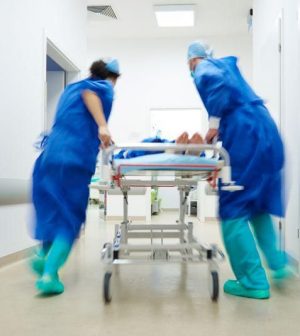- Skip Storing This Everyday Product in the Fridge Door
- Green Tea + B3 Pairing May Boost Brain Health
- Navigating Your Midlife Crisis: Embracing New Possibilities
- City Raccoons Showing Signs of Domestication
- Mapping the Exposome: Science Broadens Focus to Environmental Disease Triggers
- One Week Less on Social Media Linked to Better Mental Health
- Your Brain Changes in Stages as You Age, Study Finds
- Some Suicide Victims Show No Typical Warning Signs, Study Finds
- ByHeart Formula Faces Lawsuits After Babies Sickened With Botulism
- Switch to Vegan Diet Could Cut Your Greenhouse Gas Emissions in Half
Almost All Americans Are Now Within 1 Hour of Good Stroke Care

Nine in 10 Americans — 91% — live within an hour of lifesaving stroke care, researchers say.
That’s up from about 80% a decade ago, due to an increase in hospitals with specialized staff, tools and resources, as well as expanded use of telestroke services that use the internet to link small and rural hospitals with stroke specialists in large facilities.
“Investments in improving stroke systems of care have been successful, and we are seeing improved access to stroke expertise and improved health care for patients who are remote from centers of expertise, so it’s a message of hope,” said study lead author Dr. Kori Zachrison, an associate professor of emergency medicine at Massachusetts General Hospital and Harvard Medical School in Boston.
The analysis of 2019 and 2020 national data showed that 91% of the U.S. population can reach an acute stroke ready hospital or center within an hour by ambulance. That rises to 96% if telestroke-capable emergency departments are included.
The findings will be presented at a conference of the American Stroke Association, held in New Orleans and virtually, Feb. 8-11.
“There is a narrow window of time for delivering disability-reducing stroke treatments,” Zachrison said in a meeting news release.
“Improving post-stroke outcomes for patients depends on a patient’s ability to access that care,” she said. “With increased implementation of telestroke, optimal stroke care has been made possible for an estimated 96% of the U.S. population, which is remarkable, considering the geographic span of our country.”
Still, the percentage of the population without access to either an acute care hospital or telestroke care varied widely by region — from 1% in the Middle Atlantic states to 9% in the Mountain West, a region that includes Arizona, Colorado, Idaho, New Mexico, Montana, Utah, Nevada and Wyoming.
“Unfortunately, geography plays a role in access to health care — if you live in rural areas your access to advance stroke care is not as available as if you live in the middle of Boston or New York City, for example,” Zachrison said. “Through telestroke, we have been able to begin to close geographic disparities and improve access to optimal care by bringing stroke expertise to patients where they are — this is profound.”
Of 5,587 emergency departments nationwide, 46% are in an acute stroke ready hospital or stroke center, the study found. Of these, 55% also have telestroke services.
Of the emergency departments that are not in an acute stroke-ready hospital or stroke center, 36% have telestroke services, according to the findings.
Research presented at meetings is typically considered preliminary until published in a peer-reviewed journal.
In May 2020, the American Heart Association’s Stroke Council issued new guidance on how to handle suspected stroke cases before they arrive at a hospital during the COVID-19 crisis and future pandemics.
More information
There’s more about stroke symptoms and treatment at the U.S. National Institute of Neurological Disorders and Stroke.
SOURCE: American Stroke Association, news release, Feb. 3, 2022
Source: HealthDay
Copyright © 2025 HealthDay. All rights reserved.










